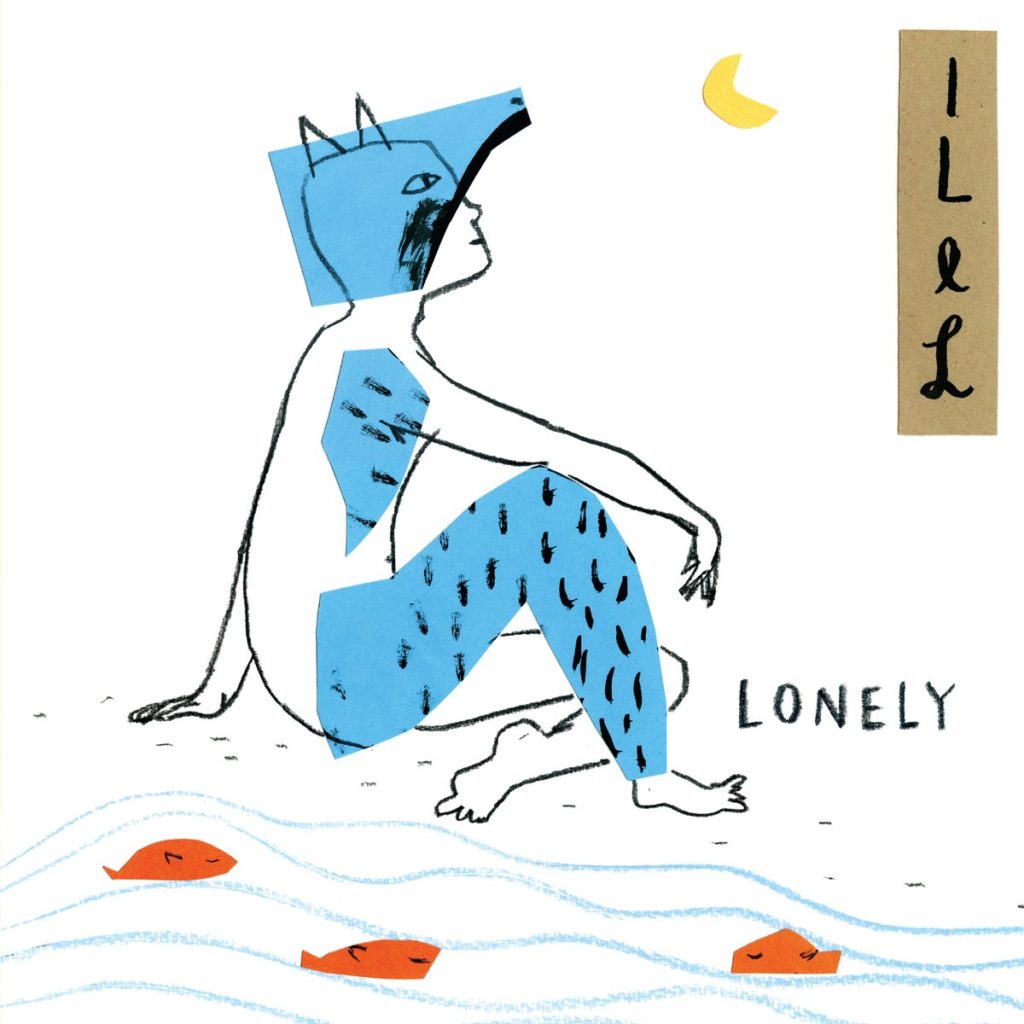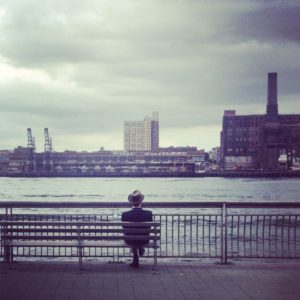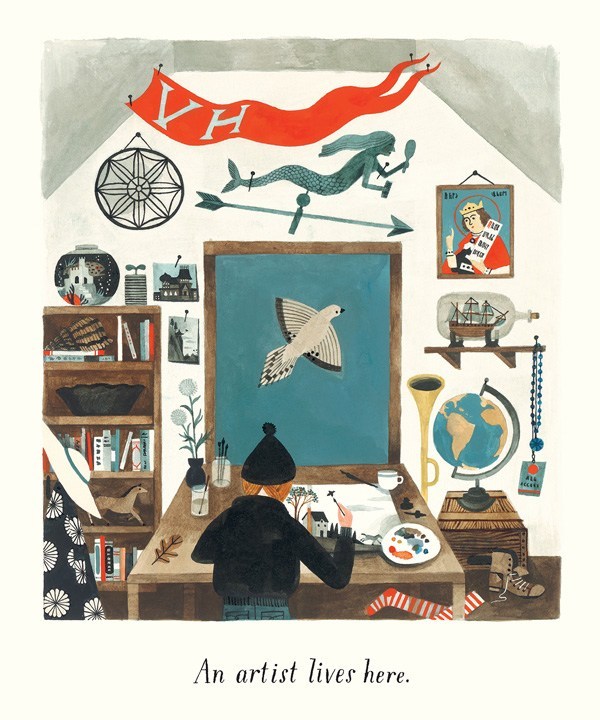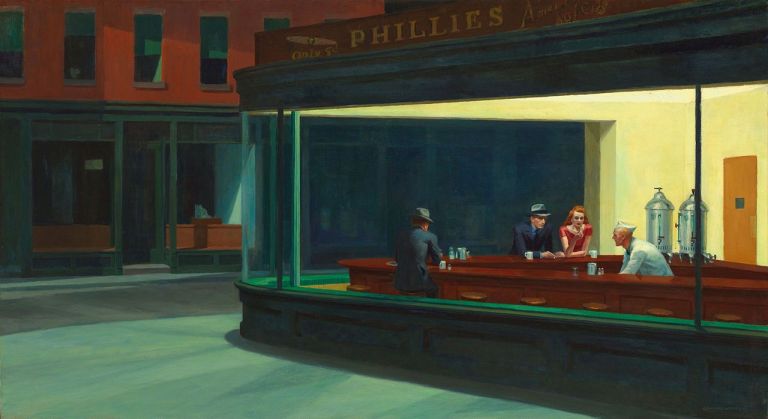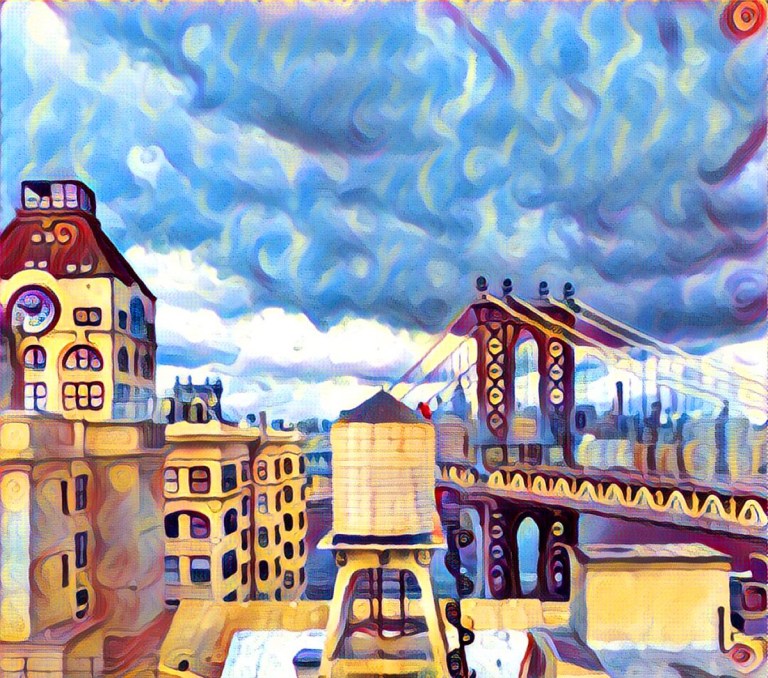The Lonely City: Adventures in the Art of Being Alone
INSPIRATIONAL, 29 Apr 2019
Maria Popova | Brain Pickings – TRANSCEND Media Service
“Loneliness is difficult to confess; difficult too to categorise. Like depression, a state with which it often intersects, it can run deep in the fabric of a person.”
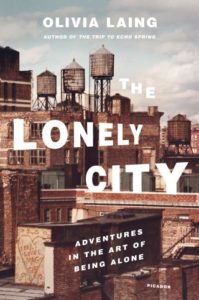 “You are born alone. You die alone. The value of the space in between is trust and love,” artist Louise Bourgeois wrote in her diary at the end of a long and illustrious life as she contemplated how solitude enriches creative work. It’s a lovely sentiment, but as empowering as it may be to those willing to embrace solitude, it can be tremendously lonesome-making to those for whom loneliness has contracted the space of trust and love into a suffocating penitentiary. For if in solitude, as Wendell Berry memorably wrote, “one’s inner voices become audible [and] one responds more clearly to other lives,” in loneliness one’s inner scream becomes deafening, deadening, severing any thread of connection to other lives.
“You are born alone. You die alone. The value of the space in between is trust and love,” artist Louise Bourgeois wrote in her diary at the end of a long and illustrious life as she contemplated how solitude enriches creative work. It’s a lovely sentiment, but as empowering as it may be to those willing to embrace solitude, it can be tremendously lonesome-making to those for whom loneliness has contracted the space of trust and love into a suffocating penitentiary. For if in solitude, as Wendell Berry memorably wrote, “one’s inner voices become audible [and] one responds more clearly to other lives,” in loneliness one’s inner scream becomes deafening, deadening, severing any thread of connection to other lives.
How to break free of that prison and reinhabit the space of trust and love is what Olivia Laing explores in The Lonely City: Adventures in the Art of Being Alone (public library) — an extraordinary more-than-memoir; a sort of memoir-plus-plus, partway between Helen MacDonald’s H Is for Hawk and the diary of Virginia Woolf; a lyrical account of wading through a period of self-expatriation, both physical and psychological, in which Laing paints an intimate portrait of loneliness as “a populated place: a city in itself.”
After the sudden collapse of a romance marked by extreme elation, Laing left her native England and took her shattered heart to New York, “that teeming island of gneiss and concrete and glass.” The daily, bone-deep loneliness she experienced there was both paralyzing in its all-consuming potency and, paradoxically, a strange invitation to aliveness. Indeed, her choice to leave home and wander a foreign city is itself a rich metaphor for the paradoxical nature of loneliness, animated by equal parts restlessness and stupor, capable of turning one into a voluntary vagabond and a catatonic recluse all at once, yet somehow a vitalizing laboratory for self-discovery. The pit of loneliness, she found, could “drive one to consider some of the larger questions of what it is to be alive.”
She writes:
There were things that burned away at me, not only as a private individual, but also as a citizen of our century, our pixelated age. What does it mean to be lonely? How do we live, if we’re not intimately engaged with another human being? How do we connect with other people, particularly if we don’t find speaking easy? Is sex a cure for loneliness, and if it is, what happens if our body or sexuality is considered deviant or damaged, if we are ill or unblessed with beauty? And is technology helping with these things? Does it draw us closer together, or trap us behind screens?
Bedeviled by this acute emotional anguish, Laing seeks consolation in the great patron saints of loneliness in twentieth-century creative culture. From this eclectic tribe of the lonesome — including Jean-Michel Basquiat, Alfred Hitchcock, Peter Hujar, Billie Holiday, and Nan Goldin — Laing chooses four artists as her companions charting the terra incognita of loneliness: Edward Hopper, Andy Warhol, Henry Darger, and David Wojnarowicz, who had all “grappled in their lives as well as work with loneliness and its attendant issues.”
She considers, for instance, Warhol — an artist whom Laing had always dismissed until she was submerged in loneliness herself.
(“I’d seen the screen-printed cows and Chairman Maos a thousand times, and I thought they were vacuous and empty, disregarding them as we often do with things we’ve looked at but failed properly to see.”)
She writes:
Warhol’s art patrols the space between people, conducting a grand philosophical investigation into closeness and distance, intimacy and estrangement. Like many lonely people, he was an inveterate hoarder, making and surrounding himself with objects, barriers against the demands of human intimacy. Terrified of physical contact, he rarely left the house without an armoury of cameras and tape recorders, using them to broker and buffer interactions: behaviour that has light to shed on how we deploy technology in our own century of so-called connectivity.
Woven into the fabric of Laing’s personal experience are inquiries into the nature, context, and background of these four artists’ lives and their works most preoccupied with loneliness. But just as it would be unfair to call Laing’s masterpiece only a “memoir,” it would be unfair to call these threads “art history,” for they are rather the opposite, a kind of “art present” — elegant and erudite meditations on how art is present with us, how it invites us to be present with ourselves and bears witness to that presence, alleviating our loneliness in the process.
Laing examines the particular, pervasive form of loneliness in the eye of a city aswirl with humanity:
Imagine standing by a window at night, on the sixth or seventeenth or forty-third floor of a building. The city reveals itself as a set of cells, a hundred thousand windows, some darkened and some flooded with green or white or golden light. Inside, strangers swim to and fro, attending to the business of their private hours. You can see them, but you can’t reach them, and so this commonplace urban phenomenon, available in any city of the world on any night, conveys to even the most social a tremor of loneliness, its uneasy combination of separation and exposure.
You can be lonely anywhere, but there is a particular flavour to the loneliness that comes from living in a city, surrounded by millions of people. One might think this state was antithetical to urban living, to the massed presence of other human beings, and yet mere physical proximity is not enough to dispel a sense of internal isolation. It’s possible – easy, even – to feel desolate and unfrequented in oneself while living cheek by jowl with others. Cities can be lonely places, and in admitting this we see that loneliness doesn’t necessarily require physical solitude, but rather an absence or paucity of connection, closeness, kinship: an inability, for one reason or another, to find as much intimacy as is desired. Unhappy, as the dictionary has it, as a result of being without the companionship of others. Hardly any wonder, then, that it can reach its apotheosis in a crowd.
As scientists are continuing to unpeel the physiological effects of loneliness, it is no surprise that this psychological state comes with an almost bodily dimension, which Laing captures vividly:
What does it feel like to be lonely? It feels like being hungry: like being hungry when everyone around you is readying for a feast. It feels shameful and alarming, and over time these feelings radiate outwards, making the lonely person increasingly isolated, increasingly estranged. It hurts, in the way that feelings do, and it also has physical consequences that take place invisibly, inside the closed compartments of the body. It advances, is what I’m trying to say, cold as ice and clear as glass, enclosing and engulfing.
There is, of course, a universe of difference between solitude and loneliness — two radically different interior orientations toward the same exterior circumstance of lacking companionship. We speak of “fertile solitude” as a developmental achievement essential for our creative capacity, but loneliness is barren and destructive; it cottons in apathy the will to create. More than that, it seems to signal an existential failing — a social stigma the nuances of which Laing addresses beautifully:
Loneliness is difficult to confess; difficult too to categorise. Like depression, a state with which it often intersects, it can run deep in the fabric of a person, as much a part of one’s being as laughing easily or having red hair. Then again, it can be transient, lapping in and out in reaction to external circumstance, like the loneliness that follows on the heels of a bereavement, break-up or change in social circles.
Like depression, like melancholy or restlessness, it is subject too to pathologisation, to being considered a disease. It has been said emphatically that loneliness serves no purpose… Perhaps I’m wrong, but I don’t think any experience so much a part of our common shared lives can be entirely devoid of meaning, without a richness and a value of some kind.
With an eye to Virginia Woolf’s unforgettable diary writings on loneliness and creativity, Laing speculates:
Loneliness might be taking you towards an otherwise unreachable experience of reality.
Adrift and alone in the city that promises its inhabitants “the gift of privacy with the excitement of participation,” Laing cycles through a zoetrope of temporary homes — sublets, friends’ apartments, and various borrowed quarters, only amplifying the sense of otherness and alienation as she is forced to make “a life among someone else’s things, in a home that someone else has created and long since.”
But therein lies an inescapable metaphor for life itself — we are, after all, subletting our very existence from a city and a society and a world that have been there for much longer than we have, already arranged in a way that might not be to our taste, that might not be how the building would be laid out and its interior designed were we to do it from scratch ourselves. And yet we are left to make ourselves at home in the way things are, imperfect and sometimes downright ugly. The measure of a life has to do with this subletting ability — with how well we are able to settle into this borrowed, imperfect abode and how much beauty we can bring into existence with however little control over its design we may have.
This, perhaps, is why Laing found her only, if temporary, respite from loneliness in an activity propelled by the very act of leaving this borrowed home: walking. In a passage that calls to mind Robert Walser’s exquisite serenade to the soul-nourishment of the walk, she writes:
In certain circumstances, being outside, not fitting in, can be a source of satisfaction, even pleasure. There are kinds of solitude that provide a respite from loneliness, a holiday if not a cure. Sometimes as I walked, roaming under the stanchions of the Williamsburg Bridge or following the East River all the way to the silvery hulk of the U.N., I could forget my sorry self, becoming instead as porous and borderless as the mist, pleasurably adrift on the currents of the city.
But whatever semblance of a more solid inner center these peripatetic escapes into solitude offered, it was a brittle solidity:
I didn’t get this feeling when I was in my apartment; only when I was outside, either entirely alone or submerged in a crowd. In these situations I felt liberated from the persistent weight of loneliness, the sensation of wrongness, the agitation around stigma and judgement and visibility. But it didn’t take much to shatter the illusion of self-forgetfulness, to bring me back not only to myself but to the familiar, excruciating sense of lack.
It was in the lacuna between self-forgetfulness and self-discovery that Laing found herself drawn to the artists who became her companions in a journey both toward and away from loneliness. There is Edward Hopper with his iconic Nighthawks aglow in eerie jade, of which Laing writes:
There is no colour in existence that so powerfully communicates urban alienation, the atomisation of human beings inside the edifices they create, as this noxious pallid green, which only came into being with the advent of electricity, and which is inextricably associated with the nocturnal city, the city of glass towers, of empty illuminated offices and neon signs.
[…]
The diner was a place of refuge, absolutely, but there was no visible entrance, no way to get in or out. There was a cartoonish, ochre-coloured door at the back of the painting, leading perhaps into a grimy kitchen. But from the street, the room was sealed: an urban aquarium, a glass cell.
[…]
Green on green, glass on glass, a mood that expanded the longer I lingered, breeding disquiet.
Hopper himself had a conflicted relationship with the common interpretation that loneliness was a central theme of his work. Although he often denied that it was a deliberate creative choice, he once conceded in an interview: “I probably am a lonely one.” Laing, whose attention and sensitivity to even the subtlest texture of experience are what make the book so wonderful, considers how Hopper’s choice of language captures the essence of loneliness:
It’s an unusual formulation, a lonely one; not at all the same thing as admitting one is lonely. Instead, it suggests with that a, that unassuming indefinite article, a fact that loneliness by its nature resists. Though it feels entirely isolating, a private burden no one else could possibly experience or share, it is in reality a communal state, inhabited by many people. In fact, current studies suggest that more than a quarter of American adults suffers from loneliness, independent of race, education and ethnicity, while 45 per cent of British adults report feeling lonely either often or sometimes. Marriage and high income serve as mild deterrents, but the truth is that few of us are absolutely immune to feeling a greater longing for connection than we find ourselves able to satisfy. The lonely ones, a hundred million strong. Hardly any wonder Hopper’s paintings remain so popular, and so endlessly reproduced.
Reading his halting confession, one begins to see why his work is not just compelling but also consoling, especially when viewed en masse. It’s true that he painted, not once but many times, the loneliness of a large city, where the possibilities of connection are repeatedly defeated by the dehumanising apparatus of urban life. But didn’t he also paint loneliness as a large city, revealing it as a shared, democratic place, inhabited, whether willingly or not, by many souls?
[…]
What Hopper captures is beautiful as well as frightening. They aren’t sentimental, his pictures, but there is an extraordinary attentiveness to them… As if loneliness was something worth looking at. More than that, as if looking itself was an antidote, a way to defeat loneliness’s strange, estranging spell.
alone_lonely solitude depression
For the artists accompanying Laing on her journey — including Henry Darger, the brilliant and mentally ill Chicago janitor whose posthumously discovered paintings made him one of the most celebrated outsider artists of the twentieth century, and the creative polymath David Wojnarowicz, still in his thirties when AIDS took his life — lonelines
s was often twined with another profound affliction of the psyche: loss. In a passage evocative of Paul Goodman’s taxonomy of the nine types of silence, Laing offers a taxonomy of lonelinesses through the lens of loss:
Loss is a cousin of loneliness. They intersect and overlap, and so it’s not surprising that a work of mourning might invoke a feeling of aloneness, of separation. Mortality is lonely. Physical existence is lonely by its nature, stuck in a body that’s moving inexorably towards decay, shrinking, wastage and fracture. Then there’s the loneliness of bereavement, the loneliness of lost or damaged love, of missing one or many specific people, the loneliness of mourning.
But this lonesomeness of mortality finds its antidote in the abiding consolations of immortal works of art. “Art holds out the promise of inner wholeness,” philosopher Alain de Botton and art historian John Armstrong wrote in their inquiry into the seven psychological functions of art, and if loneliness is, as Laing puts it, “a longing for integration, for a sense of feeling whole,” what better answer to that longing than art? After all, in the immortal words of James Baldwin, “only an artist can tell, and only artists have told since we have heard of man, what it is like for anyone who gets to this planet to survive it.”
Looking back on her experience, Laing writes:
There are so many things that art can’t do. It can’t bring the dead back to life, it can’t mend arguments between friends, or cure AIDS, or halt the pace of climate change. All the same, it does have some extraordinary functions, some odd negotiating ability between people, including people who never meet and yet who infiltrate and enrich each other’s lives. It does have a capacity to create intimacy; it does have a way of healing wounds, and better yet of making it apparent that not all wounds need healing and not all scars are ugly.
If I sound adamant it is because I am speaking from personal experience. When I came to New York I was in pieces, and though it sounds perverse, the way I recovered a sense of wholeness was not by meeting someone or by falling in love, but rather by handling the things that other people had made, slowly absorbing by way of this contact the fact that loneliness, longing, does not mean one has failed, but simply that one is alive.
But as profoundly personal as loneliness may feel, it is inseparable from the political dimensions of public life. In a closing passage that calls to mind Audre Lorde’s clarion call for breaking our silences against structural injustice, Laing adds:
There is a gentrification that is happening to cities, and there is a gentrification that is happening to the emotions too, with a similarly homogenising, whitening, deadening effect. Amidst the glossiness of late capitalism, we are fed the notion that all difficult feelings — depression, anxiety, loneliness, rage — are simply a consequence of unsettled chemistry, a problem to be fixed, rather than a response to structural injustice or, on the other hand, to the native texture of embodiment, of doing time, as David Wojnarowicz memorably put it, in a rented body, with all the attendant grief and frustration that entails.
I don’t believe the cure for loneliness is meeting someone, not necessarily. I think it’s about two things: learning how to befriend yourself and understanding that many of the things that seem to afflict us as individuals are in fact a result of larger forces of stigma and exclusion, which can and should be resisted.
Loneliness is personal, and it is also political. Loneliness is collective; it is a city. As to how to inhabit it, there are no rules and nor is there any need to feel shame, only to remember that the pursuit of individual happiness does not trump or excuse our obligations to each another. We are in this together, this accumulation of scars, this world of objects, this physical and temporary heaven that so often takes on the countenance of hell. What matters is kindness; what matters is solidarity. What matters is staying alert, staying open, because if we know anything from what has gone before us, it is that the time for feeling will not last.
*******************
The Lonely City is a layered and endlessly rewarding book, among the finest I have ever read. Complement it with Rebecca Solnit on how we find ourselves by getting lost, David Whyte on the transfiguration of aloneness, Alfred Kazin on loneliness and the immigrant experience, and Sara Maitland on how to be alone without being lonely.
_______________________________________
 Brain Pickings is the brain child of Maria Popova, an interestingness hunter-gatherer and curious mind at large obsessed with combinatorial creativity who also writes for Wired UK and The Atlantic, among others, and is an MIT Futures of Entertainment Fellow. She has gotten occasional help from a handful of guest contributors. Email: brainpicker@brainpickings.org
Brain Pickings is the brain child of Maria Popova, an interestingness hunter-gatherer and curious mind at large obsessed with combinatorial creativity who also writes for Wired UK and The Atlantic, among others, and is an MIT Futures of Entertainment Fellow. She has gotten occasional help from a handful of guest contributors. Email: brainpicker@brainpickings.org
Go to Original – brainpickings.org
Tags: Art, Books, Culture, Philosophy, Psychology
DISCLAIMER: The statements, views and opinions expressed in pieces republished here are solely those of the authors and do not necessarily represent those of TMS. In accordance with title 17 U.S.C. section 107, this material is distributed without profit to those who have expressed a prior interest in receiving the included information for research and educational purposes. TMS has no affiliation whatsoever with the originator of this article nor is TMS endorsed or sponsored by the originator. “GO TO ORIGINAL” links are provided as a convenience to our readers and allow for verification of authenticity. However, as originating pages are often updated by their originating host sites, the versions posted may not match the versions our readers view when clicking the “GO TO ORIGINAL” links. This site contains copyrighted material the use of which has not always been specifically authorized by the copyright owner. We are making such material available in our efforts to advance understanding of environmental, political, human rights, economic, democracy, scientific, and social justice issues, etc. We believe this constitutes a ‘fair use’ of any such copyrighted material as provided for in section 107 of the US Copyright Law. In accordance with Title 17 U.S.C. Section 107, the material on this site is distributed without profit to those who have expressed a prior interest in receiving the included information for research and educational purposes. For more information go to: http://www.law.cornell.edu/uscode/17/107.shtml. If you wish to use copyrighted material from this site for purposes of your own that go beyond ‘fair use’, you must obtain permission from the copyright owner.
